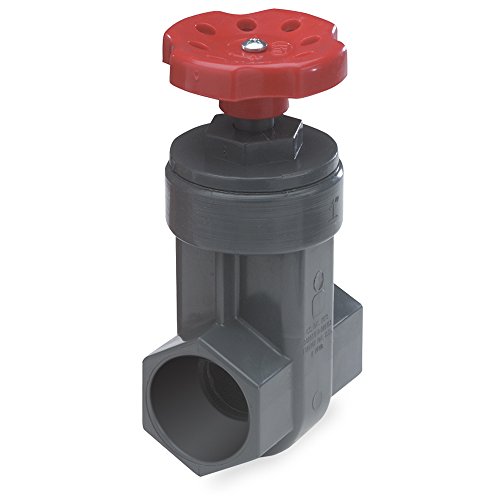Hey! This site is reader-supported and we earn commissions if you purchase products from retailers after clicking on a link from our site.
Valves are an integral part of any piping system, whether that be a compressed air system or for conveying liquids and other gases. They are typically used to control and regulate the media in question.
Globe valves and gate valves are two of the most common types of valves found across industries. They have significant differences in their design, mechanisms, applications, and more, and so, this article will provide you with all the relevant information on both!
Table of Contents
- What is a Globe Valve?
- What is a Gate Valve?
- The Differences Between Globe Valves & Gate Valves
- FAQs (Frequently Asked Questions)
What is a Globe Valve?
The globe valve is a member of the linear motion valve family and is aptly named because its body design typically represents the shape of the globe. Its key function is stopping and starting the flow of a medium as well as being able to regulate it.
These types of valves offer a tight seal with little chance of leakage. Modern globe valves may adopt varying body shapes like a plug-like disc which allows or blocks the flow. Globe valves are great for throttling flow too, given that their seats are parallel to the flow. They do not erode when on but can be liable to high-pressure drops due to their design.
Here’s an example of a globe valve readily available on Amazon!
- Compression Style Stop Valve Ideal for Stopping, Starting, and Regulating Fluid Flow in Pipelines
Prices pulled from the Amazon Product Advertising API on:
Product prices and availability are accurate as of the date/time indicated and are subject to change. Any price and availability information displayed on [relevant Amazon Site(s), as applicable] at the time of purchase will apply to the purchase of this product.
Globe Valve Advantages
- Capable of regulating and throttling flow
- Resist erosion
- Tight seal
Globe Valve Disadvantages
- Can only be installed in one direction
- Liable to high-pressure drops
- More expensive than similarly sized gate valves
What is a Gate Valve?
Gate valves are also linear motion valves that are ideal for shutoff applications, especially emergencies. These types of valves utilize a wedge-like disc which helps to isolate the flow of the medium and can provide a very tight seal.
They do not cause high-pressure drops because they do not obstruct the flow of the medium. The gate’s operation is perpendicular to the medium, the gate moves upwards to open the valve or downwards to close the valve and create a seal with the seats.
Gate valves cannot be used to regulate flow because if they’re left in a partially open position they’re prone to eroding rapidly, which will damage the valve and cause a shorter lifespan.
Here’s an example of a gate valve readily available on Amazon!
- Made in the USA with quality polyone schedule 80 PVC ii material
Prices pulled from the Amazon Product Advertising API on:
Product prices and availability are accurate as of the date/time indicated and are subject to change. Any price and availability information displayed on [relevant Amazon Site(s), as applicable] at the time of purchase will apply to the purchase of this product.
Gate Valve Advantages
- Allow uniform linear flows and are bi-directional
- Can provide an unobstructed flow in the fully open position so pressure loss is at an absolute minimum
- Prevent water hammer due to wedge slow operation
Gate Valve Disadvantages
- Can only be completely open or completely closed with no adjustments for the flow allowed
- Operation speed is slow due to the gate valve’s high opening height
- Valve’s seat and gate will erode badly if kept in partially open state
The Differences Between Globe Valves & Gate Valves
Given the definitions of the globe valve and gate valve, along with their advantages and disadvantages, you should have a good idea already about the differences between them. But, I would like to dig into it a bit further and focus on the following differences:
- Design
- Mechanism
- Price
- Uses
Design
One of the biggest differences between a globe valve and a gate valve is their design. A globe valve has most of its parts inside the cavity itself as its primary purpose is to throttle and provide a positive shut-off.
This design allows obstructions that aid the globe valve in its purpose and permits changes in the flow direction and rate, which contributes to its high-pressure drop.
On the other hand, a gate valve has a far simpler design where much of its components are located at the top part of the valve body. When the valve is on, the body becomes hollow which is why they have little pressure drop in comparison to globe valves. Globe valves have a rising stem while a gate valve may have a rising or non-rising stem.
The gate valve is designed for isolation of the medium and not flow control, while the globe valve is designed as more of a control valve. Gate valves cannot handle the strength of flow when in a partially open position.
Mechanism
A globe valves disc moves parallel to the medium flow. A full flow means that the disc only needs to move slightly from the seat, they are designed to allow throttling and offer a tight shutoff. The disc within the globe valve is designed to move up and down from the seat.
These parallel vertical movements allow the space between the disc and the seat to change ever so slowly when the valve starts to close, which in turn gives the valve the good throttling ability and allows it to regulate the flow within a pipeline.
A gate valve on the other hand uses a movable gate, or otherwise referred to as a door, which opens and closes the valve. A mechanically assisted operator lowers or raises the gate to either provide full flow or no flow at all.
The resistance of flow when the valve is fully opened is a lot smaller than globe valves because the gate is entirely out of the way, therefore flow is not obstructed.
Price
If both valves are of the same size and specifications, globe valves are typically more expensive than gate valves. Gate valves prices to significantly increase with size and so you may find larger gate valves being more costly than globe valves.
Uses
As globe valves are typically unidirectional, they are better suited to applications where there are no significant pressure fluctuations. In contrast, gate valves are bi-directional and are suited to applications that require significantly low-pressure drops.
Gate valves are better suited to applications that require strict sealing but do not need as frequent switching between open and closed. They cannot be used for regulating or throttling like globe valves are suitable for because it is impossible to achieve the accurate control with them that glove valves offer.
Globe valves are commonly found to be used with corrosive and highly viscous media as well as in high temperature and high-pressure systems. Both types of valves can commonly be found in plants within the oil and gas industry.
FAQs (Frequently Asked Questions)
The main difference between a gate valve and a globe valve aside from their design, is that gate valves are used only for allowing or blocking air flow, while a globe valve can provide that along with the ability to offer control of the flow via throttling or regulating.
Globe valves are designed and used for many applications across many industries. Though each globe valve design will offer different functions, they are generally used for stopping, starting and regulating flow within piping systems.
Globe valves are one of many types of control valves. They are often seen as the industry standard for control valves as they are able to offer good regulating flow, whereas other control valves like a ball valve are better for on/off control without pressure drop. Globe valves do however produce higher pressure drops and so, they’re suited to control applications where pressure drop is not a controlling factor.
Gate valves are good for completely shutting off a mediums flow with a tight seal. They are also good for offering unobstructed flow with minimal pressure drop when they’re set as fully open. Gate valves also offer bi-directional flow.
Additional valve reading:
- Types of Compressed Air Valves – Guide To Pneumatic Valves
- Pneumatic Flow Control Valves – What Are They, How Do They Work?
- Air Compressor Air Line Non-Return valves/Inline (In The Air Line) Air Check Valves Explained
- Check Valve Sizes
- What is Check Valve Cracking Pressure
- Air Compressor Troubleshooting Check Valve
- Air Compressor Unloader Valve Explained
- Unloader Valves On Twin V Piston Compressor Guide
- 5 3 Valves Explained
- 5-2 Air Valves
- 4-2 Compressed Air Valves
- 3-2 Air Valves
- Drawing a 5/3 compressed air valve
- Draw A 5/2 Air Valve
- Pneumatic Soft Start Valves
- Solenoid Pilot Air Valves
- Compressed Air Solenoid Valve Guide
- Air Compressor Auto Drain Valves Guide
- Needle Valve vs Ball Valve
- Globe Valve vs Ball Valve
- Butterfly Valve vs Gate Valve
If you have any questions regarding globe valves vs gate valves, please leave a comment below, with a photo if applicable, so that someone can help you!







